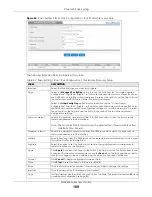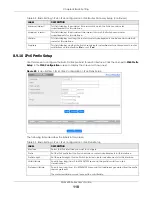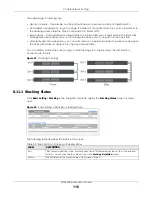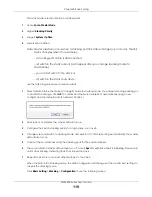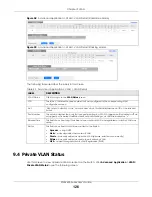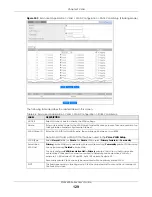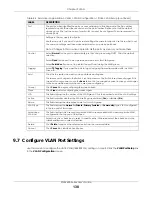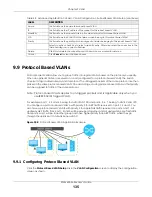
XGS4600 Series User’s Guide
121
C
HAPTER
9
VLAN
9.1 Overview
This chapter shows you how to configure 802.1Q tagged and port-based VLANs.
The type of screen you see here depends on the
VLAN Type
you selected in the
Switch Setup
screen
which is only available in standalone mode. The Switch does not support port-based VLANs in stacking
mode.
9.1.1 What You Can Do
• Use the
VLAN
screen (
) to view and search all static VLAN groups.
• Use the
VLAN Detail
) to view detailed port settings and status of the
static VLAN group.
• Use the
Private VLAN Status
screen (
) to view all private VLANs created on the
Switch.
• Use the
Static VLAN
Setup
screen (
) to configure a static VLAN for the Switch.
• Use the
VLAN Port Setup
) to configure the static VLAN (IEEE 802.1Q)
settings on a port.
• Use the
Subnet Based VLAN Setup
) to set up VLANs that allow you to
group traffic into logical VLANs based on the source IP subnet you specify.
• Use the
Protocol Based VLAN Setup
) to set up VLANs that allow you
to group traffic into logical VLANs based on the protocol you specify.
• Use the
Voice VLAN
Setup
) to set up VLANs that allow you to group
voice traffic with defined priority and enable the Switch port to carry the voice traffic separately from
data traffic to ensure the sound quality does NOT deteriorate.
• Use the
MAC Based VLAN Setup
screen (
) to set up VLANs that allow you to
group untagged packets into logical VLANs based on the source MAC address of the packet. This
eliminates the need to reconfigure the Switch when you change ports. The Switch will forward the
packets based on the source MAC address you set up previously.
• Use the
Vendor ID Based VLAN Setup
screen (
) to set up VLANs that allow
you to group untagged packets into logical VLANs based on the source MAC address of the packet.
You can specify a mask for the MAC address to create a MAC address filter and enter a weight to set
the VLAN rule’s priority.
9.1.2 What You Need to Know
Read this section to know more about VLAN and how to configure the screens.
Содержание XGS4600 Series
Страница 24: ...24 PART I User s Guide ...
Страница 44: ...44 PART II Technical Reference ...
Страница 180: ...Chapter 13 Spanning Tree Protocol XGS4600 Series User s Guide 180 Figure 145 MSTP and Legacy RSTP Network Example ...
Страница 189: ...Chapter 16 Mirroring XGS4600 Series User s Guide 189 Figure 150 Advanced Application Mirroring Standalone Mode ...
Страница 244: ...Chapter 22 Policy Rule XGS4600 Series User s Guide 244 Figure 189 Policy Example EXAMPLE ...
Страница 277: ...Chapter 25 Multicast XGS4600 Series User s Guide 277 Figure 215 Advanced Application Multicast MVR Standalone Mode ...
Страница 559: ...Chapter 59 Access Control XGS4600 Series User s Guide 559 Figure 460 Example Lock Denoting a Secure Connection EXAMPLE ...
Страница 586: ...Chapter 69 Configure Clone XGS4600 Series User s Guide 586 Figure 479 Management Configure Clone Standalone Mode ...
Страница 587: ...Chapter 69 Configure Clone XGS4600 Series User s Guide 587 Figure 480 Management Configure Clone Stacking Mode ...
Страница 594: ...Chapter 71 Port Status XGS4600 Series User s Guide 594 Figure 485 Management Port Status Port Details Standalone Mode ...
Страница 604: ...604 PART III Troubleshooting and Appendices ...



